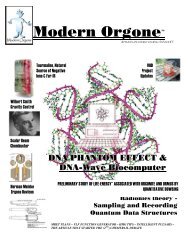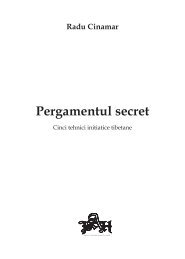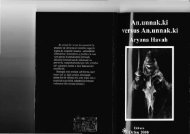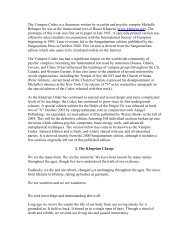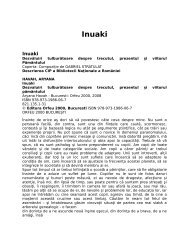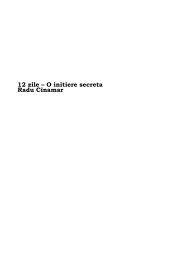Modern Orgone - Transkommunikation.ch
Modern Orgone - Transkommunikation.ch
Modern Orgone - Transkommunikation.ch
Create successful ePaper yourself
Turn your PDF publications into a flip-book with our unique Google optimized e-Paper software.
directed through a lens system and a DNA<br />
sandwi<strong>ch</strong> sample as shown diagrammatically<br />
below.<br />
Figure: Synonymy versus Homonymy<br />
(below –ed.) Diagram 1. Illustrates the workings<br />
of the experiment whi<strong>ch</strong> employs a dynamic light<br />
scattering system of the type Malvern.<br />
This understanding is then compared in section 3<br />
with an entirely independently resear<strong>ch</strong>ed<br />
prospective obtained by Marcer, and S<strong>ch</strong>empp<br />
[1996].<br />
This shows the scattering by the DNA sample of<br />
the laser light, whi<strong>ch</strong> is then guided through another<br />
lens system into the type Malvern analysing device,<br />
whi<strong>ch</strong> counts the photons registered in different<br />
serial <strong>ch</strong>annels.The results of two experiments are<br />
shown at end of paper: the first entitled<br />
“Background - Empty Space”, done without a DNA<br />
sample, and the second, with it in place, entitled<br />
“Physical DNA in SSC Solution”.<br />
The latter has the typical form of a periodically<br />
reoccurring pattern, whi<strong>ch</strong> is of the same functional<br />
type as found in an autocorrelation. Su<strong>ch</strong> regularly<br />
occurring periodic patterns have an interpretation in<br />
terms of the phenomenon of so-called Fermi-Pasta-<br />
Ulam recurrence, whi<strong>ch</strong> concerns solitonic waves.<br />
That is to say, this interpretation says that roughly<br />
speaking, the DNA, considered as a liquid-crystal<br />
gel-like state, acts on the incoming light in the<br />
manner of a solitonic Fermi-Pasta-Ulam lattice, as<br />
illustrated here:<br />
The leading question, if this is the case, is what<br />
could su<strong>ch</strong> action a<strong>ch</strong>ieve? The starting idea was<br />
that it must be concerned with the reading of the<br />
genetic texts encoded in the DNA, where however<br />
this language metaphor is now applied directly to<br />
these texts. That is to say, rather than the usual<br />
analogy taking su<strong>ch</strong> texts as a digital computer<br />
language or symbolic instruction code, su<strong>ch</strong> texts<br />
are considered instead as having the semantic and<br />
generative grammatical features of a spoken or<br />
written context dependent human language. That is,<br />
we conceived of the DNA acting in the same way<br />
as the human would, when presented with a text<br />
from a good book on a fascinating theme, whi<strong>ch</strong>, as<br />
it is read, invokes actual 3 dimensional<br />
pictures/images in the mind’s eye.<br />
The reason for this <strong>ch</strong>oice concerned the problem in<br />
DNA coding raised by the question of synonymy<br />
and homonymy as it applies to the third<br />
element/codon of the codon triplets. For while, see<br />
figure below, synonymy even seems to provide a<br />
kind of redundancy, homonymy constitutes a<br />
serious difficulty under the often proposed<br />
postulate that only the first two elements of the<br />
DNA codon triplet (standing for a particular<br />
protein- the picture in the mind’s eye, so to speak)<br />
are the significant ones. That is to say, how does<br />
the reading ribosome know whi<strong>ch</strong> protein has to be<br />
generated, if the third nucleotide in codon’s triplet<br />
does not of itself provide the answer with total<br />
certainty? The proposed answer was, that this<br />
ambiguity might be resolved by some kind of<br />
context dependent reading similar to that inherent<br />
in human spee<strong>ch</strong> and language understanding.<br />
Satisfyingly, this need to explain how su<strong>ch</strong> contextdependent<br />
reading might be implemented in the<br />
DNA reduplication/reading process, as will be<br />
shown, led back to the experimental evidence as<br />
presented above, for it supports the postulate that<br />
su<strong>ch</strong> context dependent reading of the DNA is<br />
indeed best understood in the framework of a<br />
biosolitonic process model.<br />
12



